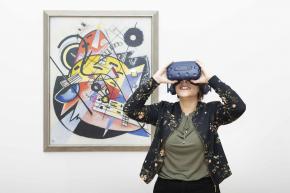
SEE, HEAR, PLAY KANDINSKY!
How does a painting sound? How do music and painting influence each other?
The painter Wassily Kandinsky (1866–1944), at any rate, repeatedly linked colours and forms with sounds in his art theory. He saw himself as a synaesthete. To him the senses of sight and hearing were interconnected, and so he was convinced that he could hear colours and
see sounds. The 1923 painting White Dot (Composition 248) bears precisely this connection between the visual and acoustic spheres. Based on overlapping zigzag lines, triangles and squares, surfaces are spatially staggered and interlaced with other elements. Some of the shapes are reminiscent of musical staves or the fingerboard of a string instrument.
Wassily Kandinsky was born in Moscow in 1866, studied in Munich and co-founded the artists’ group Blauer Reiter there. In 1922, he accepted an invitation from Walter Gropius to become a teacher at the Bauhaus in Weimar, a progressive art school seeking to bridge the division between architecture, art and handicraft. Here, Kandinsky developed his theory of form and colour according to Kandinsky, blue corresponded most to a circle, red to a square and yellow to a triangle. Then, in turn, he assigned tones to the colours: yellow, for example, was a high tone for him.
Multimedia composer Konstantina Orlandatou from the Hochschule für Musik und Theater Hamburg (University of Music and Drama Hamburg) was inspired by Wassily Kandinsky’s reflections for this virtual reality installation. As a qualified composer, she at the same time reinterpreted his painting and made useof the freedom permitted by his descriptions. Isolating various elements of the painting, she arranged them in space and assigned them certain tones and inter-active properties. She thus offers all
users a rich, manifold field of sound and resonance.
Perceiving the world outside either set apart through a window pane or stepping directly into life through the door – Kandinsky described these two positions in his well-known book Punkt und Linie zur Fläche (Point and Line to Plane), published in 1926. With regard to works of art, he further explained: »Here, too, the possibility is given of stepping into the work, becoming active in it and experiencing its pulsation with all our senses.« (p. 11)
In our digital world, the installation nowliterally enables us to do just that: try it out!
The project Moving Sound Pictures is supported by:
Innovative Hochschule
Bundesministerium für Bildung und Forschung
Gemeinsame Wissensschaftskonferenz
Projekt at the Hamburger Kunsthalle is supported by:
Ministry of Culture and Media Hamburg
Innovationsoffensive Hamburger Museen











